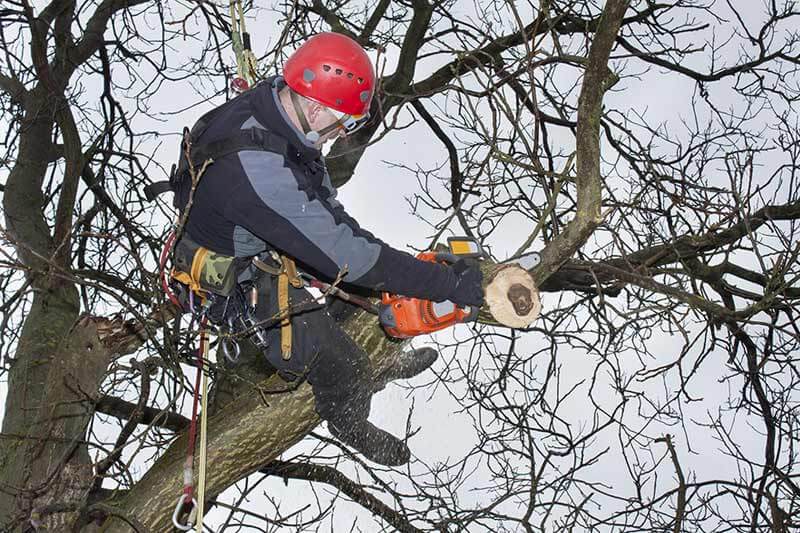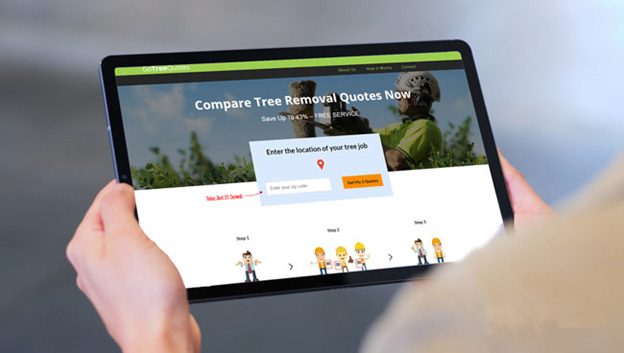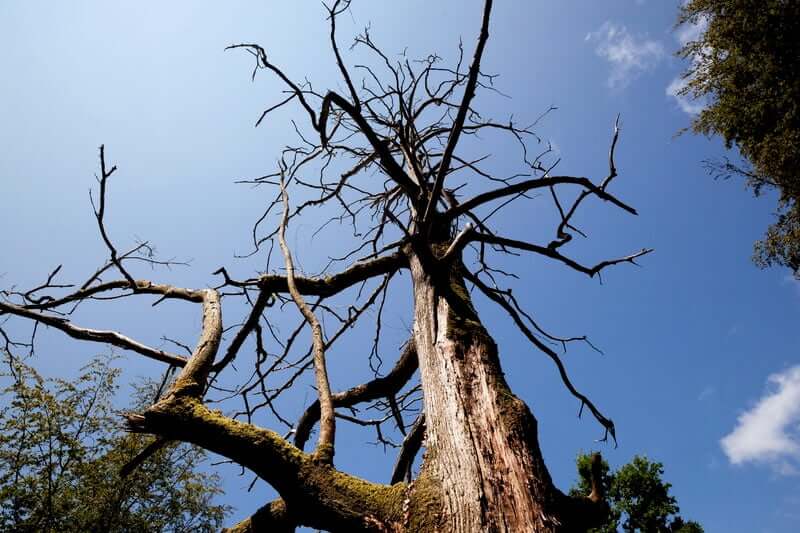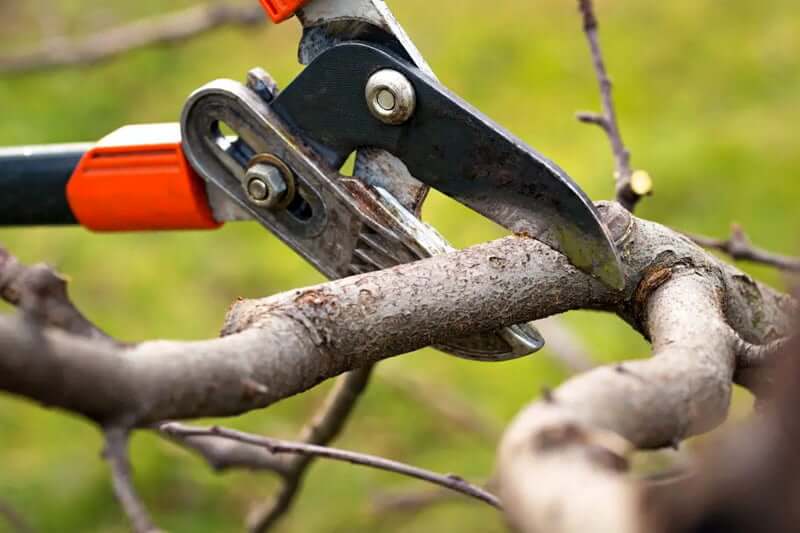Having deadwood in mature trees is a common occurrence. Processes such as fungal colonization, storms, disease, lack of sap, or even lack of water often lead to the decay of some branches.
Deadwooding your tree reduces the risk of falling branches, improves aesthetics, its overall health, and vigor, and keeps bug infestations to a minimum.
Deadwood mostly occurs on mature trees and is usually hard to reach. Correctly removing deadwood requires professional intervention to ensure safety.
Reasons to remove deadwood from your trees
Deadwood removal and tree health
Deadwood threatens the health of your tree. If there are dead branches in your tree, you should not wait until a thunderstorm comes through and snaps the dead branches off.
This will expose the heartwood of the tree and the rough ends of the broken branches make a perfect site for insects to make their homes. The fissures will also become a home for water accumulation. The moisture favors fungus and decay organisms, leading to trunk rot.
This occurrence will end up leaving you with a deceased and rotting tree. Deadwooding your tree is a maintenance effort to always keep the tree’s health at par.
Deadwood removal and associated liabilities
Even if you refuse to deadwood your tree, it is very certain that it will break off and fall one day. When it does so unexpectedly, it can cause quite a bit of damage.
- If you’re lucky, the branch will hit the ground and kick up some dirt and grass which you may need to replace.
- The unlucky ones may need to call their home or auto insurers to help repair a roof or fix a newly dented car hood as a result of falling branches.
- For the very unfortunate ones, it may lead to an unexpected accident. When the unthinkable happens, it could turn a peaceful day into a day of panic at the hospital.
Dead branches on trees become brittle and this makes them prone to breaking off during storms and even light winds. A falling branch may cause property damage or injury to humans and pets when it snaps.
By having a certified arborist remove the deadwood in your trees safely, you will be able to eliminate all sorts of liability that can arise from a sudden fall. This is even more applicable for dead wood that has a diameter greater than 2 inches. Smaller branch removal is more favorable for the health of the tree than for liability.
Deadwood removal and moisture management
When you deadwood a tree, you can use it to establish a forest-like ecosystem. This requires that you keep the woods on your property. The nutrient bed method benefits trees and landscape plantings by encouraging forest growth and improving soil microbiology.
The land is able to retain moisture for longer while draining much better. This process helps to increase the ability of your trees and other plants to absorb necessary nutrients from the soil.
The result of this type of deadwooding is a sustainable ecosystem that supports healthier foliage and disease resistance in the surrounding trees and landscaping plants.
Deadwood removal and better aesthetics
Having too much deadwood on your tree is not aesthetically pleasing. It reduces the tree’s capability to grow into its proper shape.
If the deadwood blocks sunlight to other parts of the tree, then the tree will not grow into the beautiful and attractive tree you’ve always dreamed of. This can adversely affect the value of your property especially if you’re planning to put it up for sale.
Deadwoods also prevent wind from blowing through the tree, and this can result in damage, or even the total destruction, of the tree. Deadwooding will help to improve the overall balance, shape, and value of the tree.
Deadwood removal and regulations
As a matter of public safety, schools and government bodies mostly have regulations requesting that dead tree branches are promptly removed.
This applies mostly to deadwood that is 30mm or greater in diameter. Falling branches, especially in public places will be regarded as a crime, and removing deadwood from the tree will help to prevent this occurrence.
Deadwood removal and pest control
Deadwood in large tree branches can serve as home to pests and this can be disastrous to the whole tree. If one of the trees in your yard is invaded by pests, it threatens the health and safety of the other trees and landscaping plants around.
Some pest epidemics and infestations have damaged and killed common trees that are integral parts of natural ecosystems. These have harmed valuable landscapes and highlighted the wide-ranging consequences arising from tree pests and diseases.
Tree pests and diseases can also affect the ability of forests to sequester and store carbon, reduce flood risk, and purify water.
Deadwooding a tree is thus a way of maintaining the values offered by the tree on the ecosystem.
Should deadwood be removed?
Deadwood should always be removed once it is sighted. This will help to maintain the health and safety of a tree and as well preserve its aesthetic.
If the dead branches are small ones that can be handled by you, you can consider doing it yourself if you’re able to use the right equipment and PPE.
On the other hand, if the tree branches are large ones and you’re not aware of the safety precautions involved, you should reach out to tree service companies to deadwood your tree with a few bucks.

Deadwood removal services near me
The fastest and easiest way to deadwood your tree is to get 3 Estimates from the most affordable tree services near you by using this FREE service.
GoTreeQuotes.com quickly matches you with the 3 tree surgeons voted #1 by previous users in your area.
- Scroll up to the top of the page and enter your ZIP Code in the blue form at the top of the page.
- Give us a few details about your deadwood removal job plus some contact information.
- Your tree details are forwarded on to the closest three tree services all voted best priced who will also price your tree job.

How to identify deadwood
Deadwood is not always easy to spot. It depends on the nature of the tree in question. If you’re not very observant, deadwood can go unnoticed for a long time.
During the winter, deadwood can be almost indistinguishable from healthy growth, except for a professional that has been trained to spot it. A few of the signs to look out for are:
No leaves
If there are any branches of your tree that have kept their leaves after the rest of the leaves have been dropped, such branches should be checked for deadwood. An exception to this is those trees — such as oaks — that keep their leaves longer into the winter season than other tree species.
Missing bark
Healthy trees naturally lose some bark, but they are constantly being replaced with new layers of bark growth. Dead branches, on the other hand, cannot replace their bark once it falls off. The smooth layers below the bark’s surface are usually exposed.
Discoloration
Sometimes the dead parts of the tree usually have a different brownish color different from that of the healthy branches. Although, it may be difficult to identify deadwood with colors in some trees and this is not a litmus test.

How does deadwood occur?
There are several ways in which deadwood may occur in your trees. Once you notice any of the causal factors, it’s an opportunity to respond promptly and perhaps even prevent the accumulation of deadwood within your trees.
Some common causes include storm damage, damage by pests and insects, fungal infections, lack of water and sunlight supply to branches, physical damage, and various tree diseases.
Why does deadwood occur in trees?
You may be wondering why a tree will have deadwood if other parts of the tree are healthy. Usually, deadwood in trees is an indication of other underlying health problems with the tree.
Unless the deadwood is a result of a storm or other physical factors, then an underlying issue is always suspected in the tree. By engaging tree experts, it’s important to examine the roots, soil, and healthy branches to find the cause of deadwood in a tree.
Cost to deadwood a tree
Even though deadwood removal is regarded differently from tree trimming, some tree service companies handle them the same way. You need to let your tree service company know what you want to do before getting a quote. You can have them come over to inspect the deadwood too.
The national average cost for tree trimming is $438. The price range for most homeowners will be between $120 and $1,190 depending on your job.
Should you ever top a tree?
Unless you’re planning to remove a tree completely, topping is not a recommended tree maintenance habit.
Tree topping is considered a harmful tree pruning practice. Some smaller shrubs are fine as well as most conifers, but topping a palm tree for example will kill it.
The most common reason given for topping trees is to reduce the size of a tree, either because it has become too large for the property or due to its deadwood. Ironically, topping has never been a viable solution to reducing size or hazard.
FAQ's
Sometimes, deadwood on your tree could be a result of physical factors. However, excessive deadwood within the crown of a tree or towards the ends of the branches can indicate that there are other issues relating to the tree’s health. Large dead branches and lots of minor deadwood can be good indicators of root problems such as honey fungus or Meriplieus.
Tree companies undertake the safe removal and pruning of branches that exhibit dieback and decay, promoted by the natural process of aging. Branches that have decayed or rotted due to disease or pest infestation are always the major target. Removal of such branches is justified for health, safety, and sanitation purposes.
Deadwood also occurs in palm trees like other trees. However, the good part of this is that the dead branches on palm trees are always the ones that are lower on the trees. Dead palm tree branches are a common occurrence that happens when new palm fronds replace existing ones.
Dead branches on palm trees are often removed by trimming or pruning the palm tree. The trimming process can also include removing old fruit stems from the tree to ensure that the tree is always ready to produce new fruits.
It is best to remove all the dead branches on a tree to prevent the spread of specific diseases. In general situations, dead and decaying branches should either be removed fully or shortened if they pose risks to people, property, and sites, and affect access.
However, it may be viable to consider other management options, such as tree felling, if the amount of deadwood on a tree is overwhelming.












